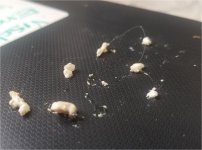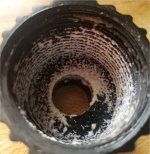Recently purchased home with indoor pool. It is separate from the house, built inside a building. There are only 3 windows in it so it gets very little sunlight. Chlorine, Alkalinity and PH all within normal limits and we have been swimming in crystal clear water for about a month.
I have a submersible pump connected to a series of DIY solar heater that output water at about 25 degrees warmer than the water temperature. Today we moved the solar heater and must have jostled them a little and I noticed white globs spitting out of the hose. I scooped them with the net and they are very sticky and gummy. Almost feel like wet caulk when you squeeze it. When you do squeeze it, it is hard to get off of your fingers and leaves them very sticky.
I noticed a few of these globs along the waterline and scrubbed them with a sponge. After awhile I had to get a new sponge because the first one was too sticky and wouldn't rinse off.
I pulled the submersible pump and this stuff is all over the bottom mesh and up into the blades and lining the hose that is attached to it. It's very hard to remove.
All levels look good, Verified with test strips and by 2 local pool supply stores. New sand in filter, And the water is still crystal clear Any ideas what this white paste might be?
I have a submersible pump connected to a series of DIY solar heater that output water at about 25 degrees warmer than the water temperature. Today we moved the solar heater and must have jostled them a little and I noticed white globs spitting out of the hose. I scooped them with the net and they are very sticky and gummy. Almost feel like wet caulk when you squeeze it. When you do squeeze it, it is hard to get off of your fingers and leaves them very sticky.
I noticed a few of these globs along the waterline and scrubbed them with a sponge. After awhile I had to get a new sponge because the first one was too sticky and wouldn't rinse off.
I pulled the submersible pump and this stuff is all over the bottom mesh and up into the blades and lining the hose that is attached to it. It's very hard to remove.
All levels look good, Verified with test strips and by 2 local pool supply stores. New sand in filter, And the water is still crystal clear Any ideas what this white paste might be?




